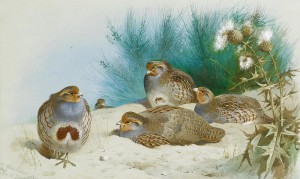
Dick’s book took me to the website of the International Council for Game and Wildlife Conservation which states on the subject of alternatives to lead ammunition:
‘In 1983, the UK’s Royal Commission on Environmental Pollution in its report on lead recommended that lead shot be withdrawn as soon as alternatives became available. This recommendation eventually led to the phasing out of lead fishing weights that were accidentally ingested by swans and to the switch to non–toxic shot in wetlands in the UK.
The latest steel shot meets most demands and is the cheapest material. It is widely used in many countries for shooting waterfowl and game-birds with ample evidence that its use is not associated with elevated levels of wounding. Copper bullets are frequently used for hunting deer and other mammals in many parts of Europe and the USA, they are generally available and there is no sound evidence of serious problems to human or wildlife health, or safety and efficacy.’.
Remember – this is a bunch of bunny-hunters not bunny-huggers.
[registration_form]
“Royal Commission on Environmental Pollution ”
Killed-off on April Fool’s Day, 2011, by the “Greenest Government Ever”.
Although I find it difficult to disagree with anything you have said I must take issue with the ICGW and its sources. Firstly the greatest problem with lead is that it is cheap! Steel shot sadly is not as effective as lead, anyone who has used it will agree. Copper bullets are used infrequently (my guess in many parts of Europe and the USA they are used for far less than 0.1% of shots) and it is problematic.
The reasons for shooting with lead are manifold and are not restricted to ballistics. Many shotguns cannot use steel shot and other alternatives are incredibly expensive. Shooters like others like the status quo and are resistant to change, also more regulation seems unpalatable.
However lead is on the way out (especially now Mr Avery is on the case!), ingestion by partridges is interesting but in my opinion irrelevant.
Surely the approach from reasonable conservationists should be to persuade shooters to abandon lead using the most relevant reason; lead is a poison and with so many people shooting it can’t continue.
I am totally persuaded by your writing and I am going to use non toxic shot here on. I am tempted to say I will lead by example!
Mark – well done and thank you!
The partridge thing is, in many ways, small beer but it interested me that Dick thought it worth mentioning and he is not a well-known anti-hunter (as everyone seems to be called by CA and Shooting Times if they mention lead being an issue).
Like you Mark I’m concerned over lead, if you are in anyway connected with the environment I don’t see how you can fail not to be.
Before the lead ban came in for shooting waterfowl it was agreed by all parties that a suitable alternative had to be found before any ban could come into force. This never happened in reality and partly because of this we have the unsatisfactory situation where shotgun and rifle shooters are highly suspicious whenever lead is mentioned.
Despite what you may or may not believe steel is not a suitable replacement to lead. Because of its ballistic characteristics it is far too unstable and does not retain its down range energy. This leads to increased wounding, something which I’m sure we can agree is highly undesirable. TMX and Bismuth, both of which have comparable ballistic characteristics and more closely ape lead, are far too cost prohibitive. In effect a suitable alternative with similar characteristics to lead shot down range and at a suitable price point have yet to be found.
It is all well and good the various protectionist bodies continually raising the issue of lead but unless they are willing to work with and alongside the shooting organisations and ammunition manufacturers, and I certainly don’t see a willingness at present from the RSPB and WWT following the LAG fiasco, then there will be impasse and a resistance from the shooting community.
Mark I must stand corrected on the evidence before me ! I will give non lead a go and see what happens.
Can’t get my thoughts around non lead on rifled barrels though as the round has to deform as it goes through the barrel in order for the rifling to spin the round. The actual gram weight of the round is not really the issue here and I was quite interested to hear that non lead ammunition is used by NTrust etc. I suspect that it is only accurate at closer ranges. I will endeavour to find out more information.
Exactly what level of contamination is found where lead shot is used regularly ? Is it really up to say levels found of heavy metals from sewage sludge (big issue with the water companies trying to get agricultural land to spread on). Amy reports you could point me to would be interesting.
Julian, the Forestry Commision Rangers tested trialled copper bullets in the South West last year and found them to be inaccurate and liable to break up in flight. Needless to say they’ve reverted back to jacketed bullets.
I have a customer whose female Harris Hawk eat a shot squirrel and nearly died because of lead poisoning. Costing him thousands in vets bills.
Oh and the squirrel was’nt dead but maimed before the hawk got it. so from one stupid idiot look at all that animal suffering, finaicial cost(vets bills, the cost of a Harris hawk) and human upset.